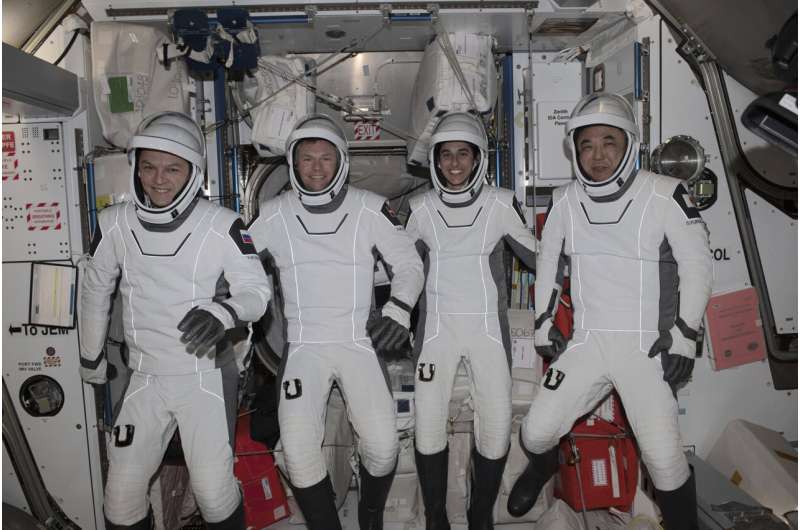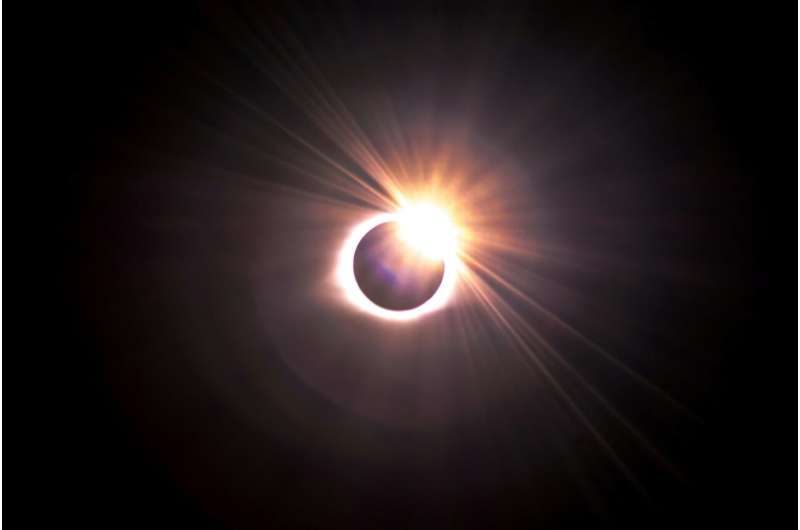
Copernical Team
The return of Andreas Mogensen | Huginn Mission
 Video:
00:03:01
Video:
00:03:01
After more than 6 months on the International Space Station, ESA astronaut Andreas Mogensen returned to Earth, marking the end of his Huginn mission. It was his second mission to the Space Station and his first long-duration, where he was the pilot of Crew-7, which consisted of Jasmin Moghbeli (NASA), Satoshi Furukawa (JAXA), and Konstantin Borisov (Roscosmos).
Four astronauts from four countries return to Earth after six months in orbit

During the 2024 solar eclipse, Texans will aid a national research effort to study the sun

On a sunny February day at Dallas' Frontiers of Flight Museum, a cluster of students lifted telescope equipment out of a bulky briefcase. A sticker on the case read: "stand back—we're going to science!"
Using a compass and a spool of green thread for alignment, the students fastened their telescope on top of a tripod with the sun framed in view.
On April 8, they'll set up the telescope again, this time on a riverbank 140 miles south of Dallas. They'll be capturing images of the total solar eclipse, when the moon will appear to completely block the sun, causing a brief period of darkness called totality.
Their work will contribute to a national research project called the Citizen Continental-America Telescopic Eclipse 2024 experiment, or CATE 2024. Led by the Southwest Research Institute the project will task crews of volunteers with handling 35 telescopes along the U.S. path of totality, with four in North Texas.
Citizen science efforts like this one will take place across the country during the eclipse, and are designed to bring scientific research out of the ivory tower.
Planet beefs up AgData with launch of Field Boundary detection technology
 Planet Labs PBC (NYSE: PL) this week unveiled its latest innovation, Field Boundaries, as part of its advanced Planetary Variables data feed series, and marking a significant advancement in agricultural data and insights.
Field Boundaries aims to revolutionize the infrastructure for agricultural solutions by offering unparalleled precision in regional crop monitoring and yield predictions
Planet Labs PBC (NYSE: PL) this week unveiled its latest innovation, Field Boundaries, as part of its advanced Planetary Variables data feed series, and marking a significant advancement in agricultural data and insights.
Field Boundaries aims to revolutionize the infrastructure for agricultural solutions by offering unparalleled precision in regional crop monitoring and yield predictions MAIAR, Ursa Space partner for Geospatial Analytics for UK Ministry of Defence
 Ursa Space Systems Inc., a leader in satellite insights, has partnered with MAIAR, a UK small business specializing in the Defence Intelligence arena, to enhance geospatial and open source analytics for NATO, with specific focus on benefitting operational users in the United Kingdom.
This collaboration leverages MAIAR's deep understanding of mission intricacies and Ursa's cutting-edge anal
Ursa Space Systems Inc., a leader in satellite insights, has partnered with MAIAR, a UK small business specializing in the Defence Intelligence arena, to enhance geospatial and open source analytics for NATO, with specific focus on benefitting operational users in the United Kingdom.
This collaboration leverages MAIAR's deep understanding of mission intricacies and Ursa's cutting-edge anal The psychological barrier of deep space exploration
 Within the next few decades, NASA aims to land humans on the Moon, set up a lunar colony and use the lessons learned to send people to Mars as part of its Artemis program. While researchers know that space travel can stress space crew members both physically and mentally and test their ability to work together in close quarters, missions to Mars will amplify these challenges. Mars is far away -
Within the next few decades, NASA aims to land humans on the Moon, set up a lunar colony and use the lessons learned to send people to Mars as part of its Artemis program. While researchers know that space travel can stress space crew members both physically and mentally and test their ability to work together in close quarters, missions to Mars will amplify these challenges. Mars is far away - Exolaunch Triumphs with 28 Satellite Deployments on SpaceX's Transporter-10 Mission
 Exolaunch, a global leader in launch mission management and satellite deployment services, announced the successful deployment of 28 customer satellites during the SpaceX Transporter-10 Rideshare mission. The mission, executed on March 4, 2024, at Vandenberg Space Force Base in California, marks another significant achievement for Exolaunch in supporting the commercial space sector and the small
Exolaunch, a global leader in launch mission management and satellite deployment services, announced the successful deployment of 28 customer satellites during the SpaceX Transporter-10 Rideshare mission. The mission, executed on March 4, 2024, at Vandenberg Space Force Base in California, marks another significant achievement for Exolaunch in supporting the commercial space sector and the small SpaceX sends 46 Starlink satellites to orbit in consecutive launches
 SpaceX on Sunday launched a total of 46 Starlink satellites into orbit in back-to-back launches in Florida and California. Against the backdrop of broken clouds and Florida swampland at dusk, SpaceX launched 23 Starlink satellites into low-Earth orbit from Cape Canaveral Space Force Station, the latest in a series of Falcon 9 launches.
The engines roared to life and sent the rocket off the
SpaceX on Sunday launched a total of 46 Starlink satellites into orbit in back-to-back launches in Florida and California. Against the backdrop of broken clouds and Florida swampland at dusk, SpaceX launched 23 Starlink satellites into low-Earth orbit from Cape Canaveral Space Force Station, the latest in a series of Falcon 9 launches.
The engines roared to life and sent the rocket off the Aireon Launches Global Coalition for Space-Based VHF Aviation Communication
 Aireon is at the forefront of aviation innovation with the establishment of the Aireon Space-Based VHF Coalition, a collaborative initiative aimed at developing space-based VHF voice and data communication services for the aviation sector. This marks a significant leap towards enhancing global air traffic safety and efficiency.
The coalition sees the partnership of industry giants includin
Aireon is at the forefront of aviation innovation with the establishment of the Aireon Space-Based VHF Coalition, a collaborative initiative aimed at developing space-based VHF voice and data communication services for the aviation sector. This marks a significant leap towards enhancing global air traffic safety and efficiency.
The coalition sees the partnership of industry giants includin Exploring the Final Frontier: The Role of Alcohol in Space Exploration
 Throughout the annals of history, alcohol has not only been a staple of human civilization but also a significant cultural and social element that has accompanied many of humanity's most monumental moments. As our gaze turns skyward and our ambitions reach for the stars, the intriguing question emerges: How will alcohol fit into the future of space exploration and settlement? "Alcohol in Space" by Chris Carberry.
Throughout the annals of history, alcohol has not only been a staple of human civilization but also a significant cultural and social element that has accompanied many of humanity's most monumental moments. As our gaze turns skyward and our ambitions reach for the stars, the intriguing question emerges: How will alcohol fit into the future of space exploration and settlement? "Alcohol in Space" by Chris Carberry. 